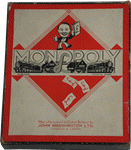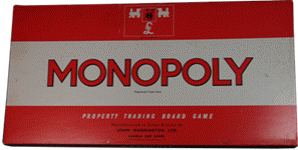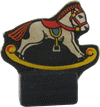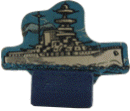Monopoly

The origins of the Monopoly board game go back to the early 1900s and a game called Landlord's Game, invented by an American Quaker, Lizzie Magie. The original idea of the game was to teach children about the evils of property speculation.
Since then several different people have designed various versions of the game. Charles Darrow designed a version with US Atlantic City street names around 1930. He distributed it under the name Monopoly and eventually sold the rights to Parker Brothers. In the 70s Parker Brothers' rights to Monopoly were disputed. However, Hasbro, Parker Brothers' parent company, still owns the brand.
John Waddington secured the rights to make a UK version of the game and the London Monopoly board was created in 1936. In my mind Monopoly was so linked to London that I was surprised to discover its American origins. The original Atlantic City street names were replaced with London street names. However, some puzzling American elements remained. What did 'Community Chest' mean? Why did the parked car look like an American car? Although by my childhood the American spelling of 'jail' was normal in the UK.
See Monopoly street names for a conversion of the US Atlantic City Street names to the London ones.
The Monopoly game in its original London form has remained pretty much unchanged since 1936. The board, the street names and the pre-inflation prices are as they were then.
A few details did change over the years. In the 70s, the houses and hotels were made of plastic instead of wood and the packaging and playing pieces moved with the times.
Monopoly boxes

1940s box

1950s box

1970s box
Early versions of the London game had a small box and the board did not fit inside the box. It was very similar to the original American version, except with pound symbols instead of dollars. Later versions from the 1960s onwards had a much larger box which included the board. In the 70s the Monopoly man character was joined by train and money symbols, as on the 70s box above.
Collectors' tip
Look out for Patent Applied For No. 3796/36 on very early UK boxes. Most 1930s versions show the patent number.
Playing pieces
First playing pieces
The very first US versions did not contain any playing pieces at all, it was simply left for the players to improvise, possibly using buttons or coins perhaps? However, when Parker Brothers took over the manufacture of the game they added metal tokens. The company that supplied them also made the prizes that went into packs of Cracker Jack, a candy flavoured pop-corn snack which was an American tradition since 1893 . The counters in the first Monopoly set: a boot, a warship, a cannon, an iron, a thimble and a top hat were Cracker Jack prizes from that era. The pre-war UK version also used these counters, although a car replaced the cannon.
Wartime playing pieces






Wartime restrictions caused the metal counters to be replaced by cardboard ones. Although some were derived from the pre-war counters, they now had more of a UK flavour. The iron was now an electric iron, representing progress. Although taken for granted now, electrical appliances made a huge difference to peoples' lives in the 1930s. The boat looks like a battleship from the Second World War. The rocking horse was new, and the boot looks rather smarter than the original version, which looked like it might have been fished up from a river.
1950s playing pieces






The 1950s pieces are very different. In the age of affluence the cardboard pieces went and there was little correlation with the original monopoly pieces. A transport theme runs throughout, but the pieces themselves are loaded with meaning: progress, patriotism and nostalgia are all represented.
Progress is in the form of the modern car (a Rover 75) and a motorbike. Both celebrate the success of British industry at home and abroad. The bulldozer represents the rebuilding of Britain after the War.
The tank is a reminder of our still (relatively) powerful armed forces. It was probably based on the Centurion heavy tank, which did not quite make it off the drawing board to take part in World War Two, but was the mainstay of the British Army in the 1950s.
The sailing ship adds a strong dose of nostalgia for a time when Britain was great. It was modelled on Sir Francis Drake's Golden Hind and coloured gold just in case you had not worked that out. The Golden Hind was a potent symbol at the time. Not only was it on the halfpenny coin, but after the Queen's Coronation in 1953, there was a feeling that Britain had entered a new Elizabethan age. It is no co-incidence that Airfix chose the Golden Hind as their first construction kit in 1954.
The train represents both progress and nostalgia. It was Sir Nigel Gresley's record breaking Mallard locomotive. In 1938 the Mallard recorded a still unbeaten speed record for a steam locomotive of 126mph. However, it is painted in the original blue livery used by the pre-nationalised LNER company. British rail trains of the time were painted in green and black. The Labour Government nationalised the railways shortly after the War. Many industry figures were against the direction that Labour took the country. The choice of this model and colour scheme looks to be a protest against nationalisation by John Waddington.
1970s pieces




Sometime in the 60s the original metal pieces returned. In the 70s the warship became a pleasure boat and the car was updated.
Resources
How old is my Monopoly - US site with photographs and descriptions of early monopoly games including some UK ones.


Comments
Ooh, I'd love to know how much the set that my hubby found in an op-shop last year...its the John Waddington Ltd one with the pat app for no.3796-36, got everything but the pieces to represent the players.
Not as much as you might expect. I've seen 1930s sets sell on eBay for £20.
I had an early sixties version with wooden houses. Although we played it a lot I can never recall actually completing a game to the extent where all except one were bankrupted. My brother and I would often end up playing scenarios with the battleship (French pre-dreadnought) and the racing car (1930s design), putting the top hat on the dog and suchlike